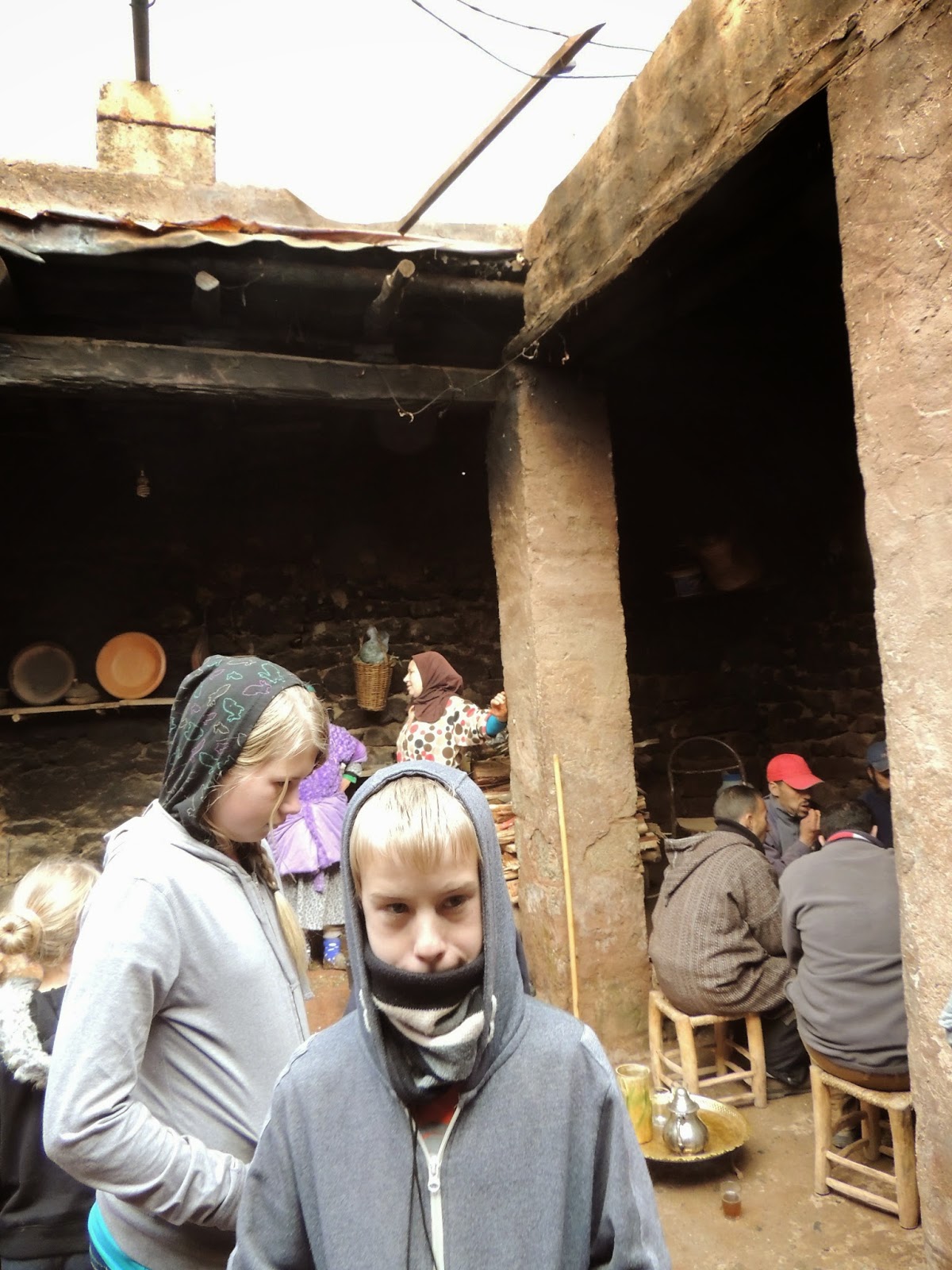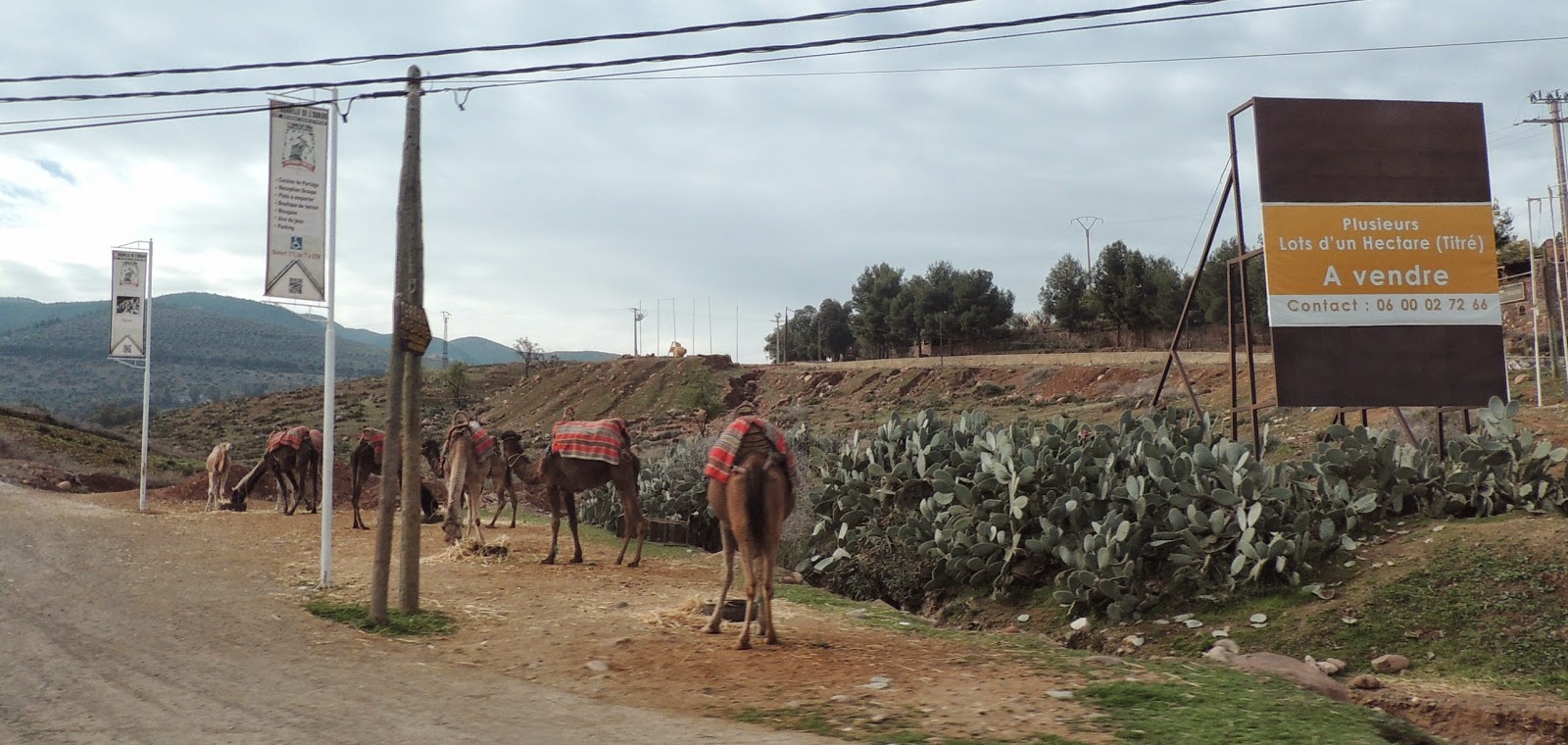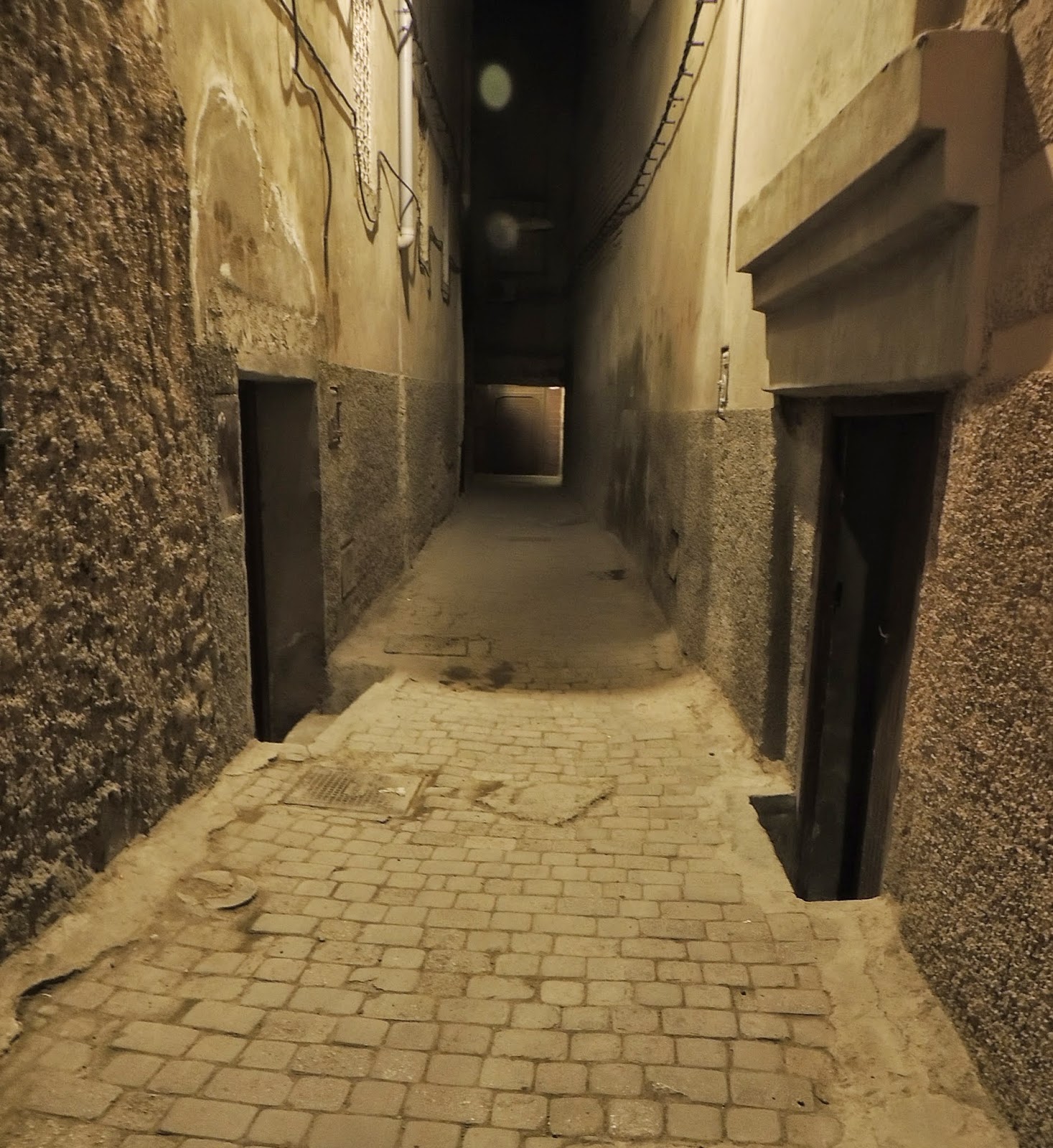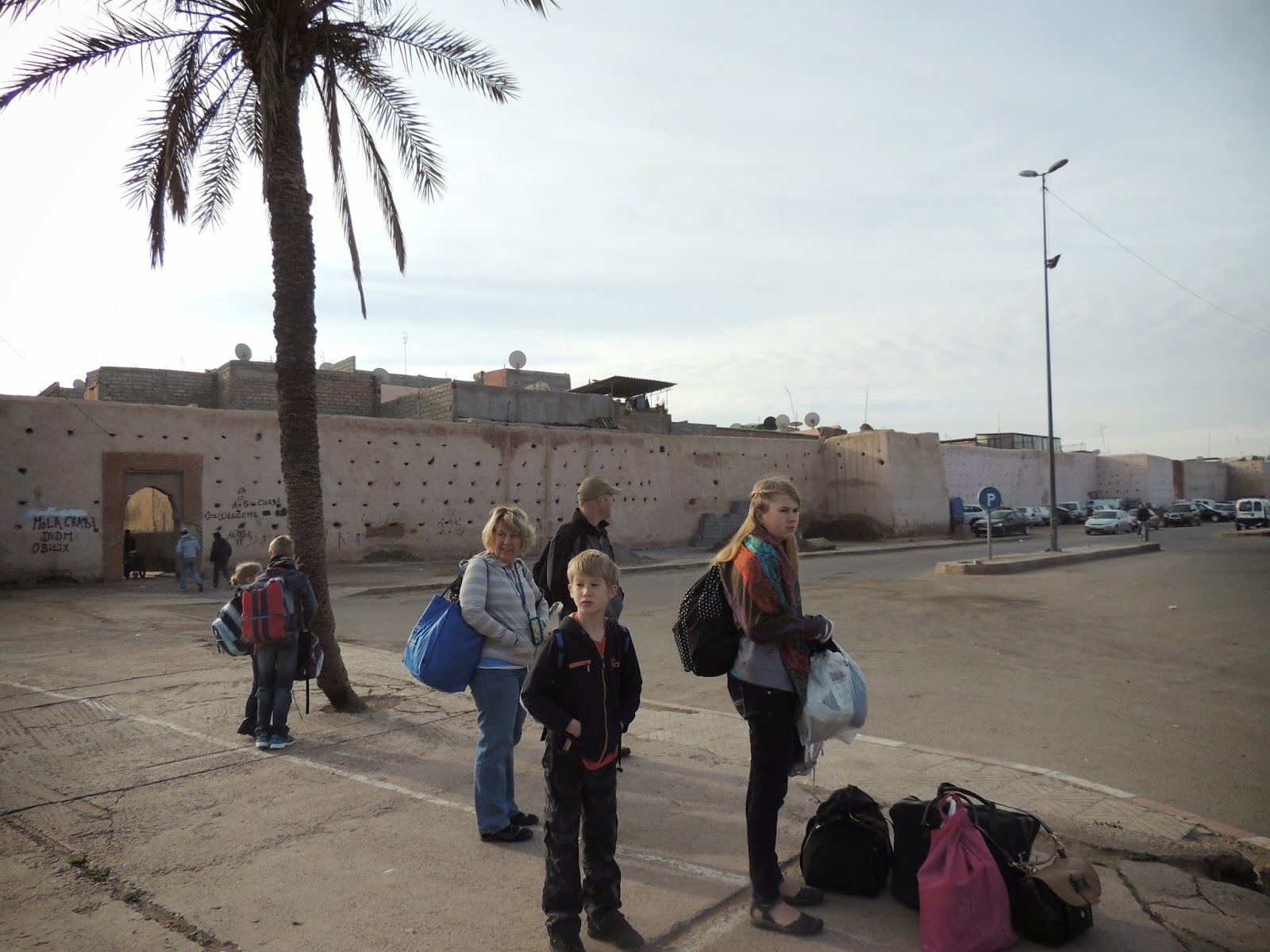This region was inhabited by Berber farmers from Neolithic times, but the actual city was founded in 1062 AD . The walls of the city, built in 1122-1123, and various buildings were constructed in red sandstone during this period.
The night we arrived, we were grateful that we had arranged for a taxi to the "riad" (a traditional Moroccan house) as it would have been quite difficult to find on our own. The taxi driver parked here and then led us into and.....
.....through the darkness in this maze of alleyways to the riad.
There were all kinds of doorways, many with step down entrances.

This was the door to our "riad" which had a step up and over entrance.
The traditional Moroccan house or palace (riad) has an interior garden or courtyard to provide family privacy and protection from the weather.
There was no indication from the bare outside walls what beauty would be found inside. It was peaceful and traditionally decorated. Behind that door pictured was bedroom #1 of our three.
 |
| Inside that doorway was this cozy room... |
 |
| ...and this bathroom. |

The other two rooms were upstairs behind Kaiya.


Bedroom #2
 |
| Bedroom #3 and it's bathroom. |

From the rooftop you could see the neighbors' courtyards across the "street" past the narrow walkways.

The next morning, we were happy to have daylight to help us find our way back through this labyrinth to the wall.
We were advised to exit the walls of the "Medina"(typically a walled city, with many narrow and maze-like streets) to better find our way to the souks (outdoor markets) and the main plaza -(Jemaa el-Fnaa). We were to simply follow the wall past 7 doorways before re-entering.

Along the wall, we had the pleasure of passing large trash piles, lines of taxis....
.... donkey carts, and
... vendors of all things edible and not etc. (this picture was from our trek back to the riad later that night)

After counting 7 entrances we re-entered the Medina but soon realized we had miscounted as we could not find the landmark Tower that was said to be easily spotted and our guide to the main square.

We did, however, find the souks and their brilliant colors...

beautiful pottery, .....

...fanciful designs,.....
...including intricate tile work,....

...way too many people,...
...and way too many bikes, scooters, and donkey carts. ( The bikes and scooters were constantly whizzing by which kept us on our toes at all times and a little tense with our four kids)

Among all the amazing sights within the souks, there were extremely strong smells from the hundreds of spice shops, restaurants etc. (At this shop you could select your dinner live and watch them kill it for you. It doesn't get much fresher than that. At another, similar shop we saw them plucking the feathers from two live chickens hanging upside down while the customers watched.)

We assume this is the Medina's two-wheeled graveyard.
We followed some questionable alleyways with most leading to more shops, some leading nowhere and some leading to water closets.
 |
| All kinds of trinkets imaginable were being sold by extremely pushy Moroccans. |
Anything "Aladdin", was available including, lamps, magic carpets, pointed slippers etc.
Practically anything was for sale within the souks of the Medina.
Jemaa el-Fna
 |
| We eventually arrived at the main plaza known as "Jemaa el-Fna" which is the busiest square in Africa. This was what it looked like at the end of our first day of wandering the souks. |

We much enjoyed the freshly squeezed orange juice within the square each morning for just about 40 cents.
Also within the Medina we heard the Muslim call to prayer, sung by an "Emam" (usually from a recording) and always amplified by speakers, five times a day. We heard this call before dawn at a very early 5:00 am, midday, afternoon, before sunset, and at nighttime.
Just off of the main square is the Koutoubia Mosque which includes the "minaret" (tower) built between 1184 and 1199. At the time that it was built, it was an "engineering feat".
Here you can see the layout of a previous mosque, destroyed apparently for an alignment problem of 5 degrees, since it was not perfectly oriented to Mecca. It is rumored that the orientation of the 2nd mosque is off 10 degrees.
The minaret truly is a symbol of Marrakesh. A local ordinance forbids anything constructed to be taller than a palm tree. The minaret has a height of 221 ft. which allows it to be seen from many viewpoints within the Medina.
Most of the restaurants were on rooftop terraces. This was our second day and the third meal on a rooftop terrace.
As we entered the restaurants we wandered through long hallways and large rooms, as we found our way to the terrace. When someone needed to use the restroom it was a gamble as to which door was the right one and not someone's bedroom. This room must have been the family room, as the man seemed to be watching TV.
Once we made it to the restaurant and rooftop we were exhausted.
It was nice to get out of all of the hustle and bustle and watch from above, while enjoying the Moroccan sun.
 |
| We saw some homeless people in alleyways and a few on rooftops. (but none with monkeys or flying carpets) |
We were so hungry by the time our yummy Moroccan food was served that I forgot to take a picture before eating most of it as usual.
The Badi Palace
The Badi palace was originally commissioned by the Saadian sultan, Ahmed el Mansour at the beginning of his reign in 1578. The money to build it came from the large ransom paid by the Portuguese after the Battle of the Three Kings.
This is not the original entrance. but the current one, to the ruins of this 16th century Moorish palace.
 This is the enormous central court
of the palace, which is over 130m long and nearly as wide. Though much is in ruins, enough of the palace "El Badi" remains to support that the meaning of its name – “The Incomparable” – "was not entirely
immodest."
This is the enormous central court
of the palace, which is over 130m long and nearly as wide. Though much is in ruins, enough of the palace "El Badi" remains to support that the meaning of its name – “The Incomparable” – "was not entirely
immodest."
Apparently the palace once had three hundred and sixty rooms and
was originally decorated in Sudanese gold, ivory, Italian marble, turquoise, crystal and cedar wood.
This massive palace's riches and decoration were so overwhelming, that it took the Sultan's successor twelve years to destroy it and strip it of anything valuable, just 75 years after its construction.
A view of one of the 4 sunken gardens.
This is the entrance to a monumental hall known as the Koubba el Hamsiniya (The Fifty Pavilion), after its size in cubits. It was used by the sultan on state occasions.
It is said that during the palace's state opening, the Sultan Ahmed's court jester commented, “This will make a magnificent ruin.”
 |
| ....used into the last century as a state prison. |

I'm not sure that this beautiful tile work is original to the 16th century palace.
From the ramparts you can again see the central courtyard that was essentially the ceremonial part of the palace complex.
The courtyard was planned for the reception of ambassadors, and not meant for everyday living.
Maisson Tiskiwin
After the Badi Palace, we made our way to the Maisson Tiskiwin, an African Musuem inside a riad. A wealthy Dutch Anthropologist collected beautiful artifacts from trips through the Saharan countries. Each room represented a different caravan stop on his journey.
Antelope figures...
weaponry.......

and a beautiful courtyard...
with four adorable kiddos.
La Koubba Almoravid
This Almoravid building is the oldest structure left standing in Marrakech. The Almoravids were a Berber tribe that conquered Marrakech in the 1100's. This building dates from 1117 AD.
These ruins were also included in the complex. The beautiful dome was once part of the worship center. The ancient ruins once included showers, toilets, and drinking fountains.

After another full day of walking, we felt brave enough to try to find our way back to the Riad without using the wall.
After wandering in circles through the souks for at least an hour, we regretted that over-confidence.

Once we got out of the seemingly endless souks we felt a little better, but still got ourselves lost a few times even with the GPS.
Our Last Day
We met our driver outside the gates to see some of the countryside, and to ride camels before we headed to the airport.We were grateful that our driver showed up in a vehicle with more space than this.
"Futbol" appeared to be quite popular here. There were several groups playing as we drove out of town.
Berbers
This was one of the many Berber villages we passed along our route. Berbers are the descendants of the pre-Arab inhabitants of North Africa. Berbers are identified primarily by language but
also by traditional customs and culture. In Morocco, about 40% claim a Berber identity, though many more have Berber ancestry. Many of the children drop out of school because they are taught in what,
to them, is a foreign language - Arabic. The Berber language is not officially recognized in Morocco. Berbers are traditionally farmers, although in past history, they helped conquer Spain for the Arabs.
 | |||||||||||||||||||||||||||||
| The interior of the home was open with various rooms on the sides. |
 |
| There appeared to be two to three bedrooms similar to this. You can see more of the flood damage in this photo. |
 |
| We caught the family in the middle of cooking and eating. |
 |
| They graciously invited us to take pictures of anything and everything which made us a bit uncomfortable. |
 | ||
| This is the food supply room which was across from the area where they were cooking and eating. |
Camels
 |
| We saw several camels along our route including these animals appropriately situated in front of large cacti. |
 |
| These camels looked a bit more out of place in front of the snowy Atlas mountains. Notice the piles of souvenirs in front of the motorbikes, ready to sell to anyone who dares stop for a camel ride. |
We eventually found the perfect camels, pulled over and were greeted by these friendly mamas and their babes.
It may appear that I was enjoying this baby camel sucking on my freshly lotioned foot, but I really disliked it as much as I dislike dogs licking me. (that heel was quite cracked and sore by the time we returned home) Unfortunately I couldn't escape it or push it away as it's head was tied just below our feet.

It took some time for everyone to mount, but we soon were plodding along.

We were a little anxious as we were all tied together along a steep and narrow pathway.
 This baby apparently didn't have enough stored in it's hump to wait a few minutes for us to finish our ride.
This baby apparently didn't have enough stored in it's hump to wait a few minutes for us to finish our ride.The ride lasted a mere 20 minutes but it felt much longer and we were more than ready for it to be over. I do not understand how anyone could cross the Sahara on one of these.
 |
| After the camels, we traveled to our next destination; a popular series of waterfalls in Setti Fatma. |
As we drove along the Ourika River, partly fed by the Setti Fatma waterfalls, we saw nearly continuous and colorful seating for outdoor restaurants.
 | ||
| We weren't sure where the food would come from or how warm it would be served to many of the tables. |
Setti Fatma Waterfalls

We eventually arrived in this small Berber village named Setti Fatma at the base of the hike to the waterfalls.
 |
| Near the beginning, we saw this super cute monkey just hanging out in this tree. |
Among other interesting things, we also saw these sodas, oranges and water bottles being cooled by the waterfall through black tubing.
We expected the hike to be simple, but it was quite technical with super slick rock and numerous bridges...
...to help us cross the river back and forth, ...

which made us glad to have a guide. (Our guide is just in front of Morgan)

We safely made it to the lesser, lower waterfall and didn't have time to go on farther to the larger one since we had a flight to catch.
Back down at the bottom: This was not the scariest and most unsafe bridge that we could have crossed along this river. Morgan really wanted to cross one of the several scary looking rope bridges.
 |
| Good-bye Marrakech- you will not soon be forgotten |
Our comforting view during our short, 2-hour flight home.
.jpg)






















































